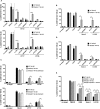Boosting Natural Killer Cell-Mediated Targeting of Sarcoma Through DNAM-1 and NKG2D
- PMID: 32082316
- PMCID: PMC7001093
- DOI: 10.3389/fimmu.2020.00040
Boosting Natural Killer Cell-Mediated Targeting of Sarcoma Through DNAM-1 and NKG2D
Abstract
Sarcomas are malignancies of mesenchymal origin that occur in bone and soft tissues. Many are chemo- and radiotherapy resistant, thus conventional treatments fail to increase overall survival. Natural Killer (NK) cells exert anti-tumor activity upon detection of a complex array of tumor ligands, but this has not been thoroughly explored in the context of sarcoma immunotherapy. In this study, we investigated the NK cell receptor/ligand immune profile of primary human sarcoma explants. Analysis of tumors from 32 sarcoma patients identified the proliferative marker PCNA and DNAM-1 ligands CD112 and/or CD155 as commonly expressed antigens that could be efficiently targeted by genetically modified (GM) NK cells. Despite the strong expression of CD112 and CD155 on sarcoma cells, characterization of freshly dissociated sarcomas revealed a general decrease in tumor-infiltrating NK cells compared to the periphery, suggesting a defect in the endogenous NK cell response. We also applied a functional screening approach to identify relevant NK cell receptor/ligand interactions that induce efficient anti-tumor responses using a panel NK-92 cell lines GM to over-express 12 different activating receptors. Using GM NK-92 cells against primary sarcoma explants (n = 12) revealed that DNAM-1 over-expression on NK-92 cells led to efficient degranulation against all tested explants (n = 12). Additionally, NKG2D over-expression showed enhanced responses against 10 out of 12 explants. These results show that DNAM-1+ or NKG2D+ GM NK-92 cells may be an efficient approach in targeting sarcomas. The degranulation capacity of GM NK-92 cell lines was also tested against various established tumor cell lines, including neuroblastoma, Schwannoma, melanoma, myeloma, leukemia, prostate, pancreatic, colon, and lung cancer. Enhanced degranulation of DNAM-1+ or NKG2D+ GM NK-92 cells was observed against the majority of tumor cell lines tested. In conclusion, DNAM-1 or NKG2D over-expression elicited a dynamic increase in NK cell degranulation against all sarcoma explants and cancer cell lines tested, including those that failed to induce a notable response in WT NK-92 cells. These results support the broad therapeutic potential of DNAM-1+ or NKG2D+ GM NK-92 cells and GM human NK cells for the treatment of sarcomas and other malignancies.
Keywords: DNAM-1 (CD226); NK-92 cell line; NKG2D (Natural killer group 2 member D); cancer immunology; cancer immunotherapy; natural killer (NK) cell; sarcoma.
Copyright © 2020 Sayitoglu, Georgoudaki, Chrobok, Ozkazanc, Josey, Arif, Kusser, Hartman, Chinn, Potens, Pamukcu, Krueger, Zhang, Mardinoglu, Alici, Temple, Sutlu and Duru.
Figures







Similar articles
-
Identification and functional analysis of ligands for natural killer cell activating receptors in colon carcinoma.Tohoku J Exp Med. 2012 Jan;226(1):59-68. doi: 10.6120/tjem.226.59. Tohoku J Exp Med. 2012. PMID: 22189020
-
The requirement for DNAM-1, NKG2D, and NKp46 in the natural killer cell-mediated killing of myeloma cells.Cancer Res. 2007 Sep 15;67(18):8444-9. doi: 10.1158/0008-5472.CAN-06-4230. Cancer Res. 2007. PMID: 17875681
-
NK cells recognize and lyse Ewing sarcoma cells through NKG2D and DNAM-1 receptor dependent pathways.Mol Immunol. 2008 Sep;45(15):3917-25. doi: 10.1016/j.molimm.2008.06.016. Epub 2008 Jul 26. Mol Immunol. 2008. PMID: 18657862
-
Cancer immunotherapy using NKG2D and DNAM-1 systems.Anticancer Res. 2012 Jun;32(6):2241-7. Anticancer Res. 2012. PMID: 22641658 Review.
-
NK cell recognition and killing of melanoma cells is controlled by multiple activating receptor-ligand interactions.J Innate Immun. 2011;3(4):365-73. doi: 10.1159/000328505. Epub 2011 May 11. J Innate Immun. 2011. PMID: 21576932 Review.
Cited by
-
Global Perspective on the Development of Genetically Modified Immune Cells for Cancer Therapy.Front Immunol. 2021 Feb 15;11:608485. doi: 10.3389/fimmu.2020.608485. eCollection 2020. Front Immunol. 2021. PMID: 33658994 Free PMC article. Review.
-
Adoptive NK Cell Therapy: A Promising Treatment Prospect for Metastatic Melanoma.Cancers (Basel). 2021 Sep 21;13(18):4722. doi: 10.3390/cancers13184722. Cancers (Basel). 2021. PMID: 34572949 Free PMC article. Review.
-
ALPL-1 is a target for chimeric antigen receptor therapy in osteosarcoma.Nat Commun. 2023 Jun 8;14(1):3375. doi: 10.1038/s41467-023-39097-x. Nat Commun. 2023. PMID: 37291203 Free PMC article.
-
CAR-NK Cells in the Treatment of Solid Tumors.Int J Mol Sci. 2021 May 31;22(11):5899. doi: 10.3390/ijms22115899. Int J Mol Sci. 2021. PMID: 34072732 Free PMC article. Review.
-
The apoptotic effects of NK-92 cells stimulated with an anti-CD226 antibody on MDA-MB-231 triple-negative breast cancer cells.Med Oncol. 2023 Jul 6;40(8):228. doi: 10.1007/s12032-023-02080-z. Med Oncol. 2023. PMID: 37410214
References
-
- Judson I, Verweij J, Gelderblom H, Hartmann JT, Schoffski P, Blay JY, et al. Doxorubicin alone versus intensified doxorubicin plus ifosfamide for first-line treatment of advanced or metastatic soft-tissue sarcoma: a randomised controlled phase 3 trial. Lancet Oncol. (2014) 15:415–23. 10.1016/S1470-2045(14)70063-4 - DOI - PubMed
-
- Penel N, Coindre JM, Giraud A, Terrier P, Ranchere-Vince D, Collin F, et al. . Presentation and outcome of frequent and rare sarcoma histologic subtypes: a study of 10,262 patients with localized visceral/soft tissue sarcoma managed in reference centers. Cancer. (2018) 124:1179–87. 10.1002/cncr.31176 - DOI - PubMed
Publication types
MeSH terms
Substances
LinkOut - more resources
Full Text Sources
Medical
Research Materials
Miscellaneous

